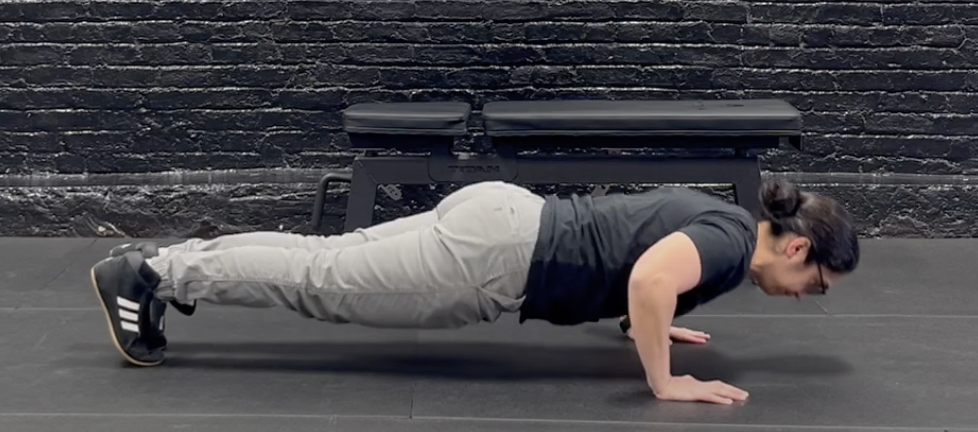What makes a well-rounded training practice?
Strength training and a basic at-home program
Training should include three main types of movement:
Lifting weights or adding resistance to movement to build strength and resilience in your muscles and connective tissues
Moving quickly and freely to increase your heart rate and build endurance
Moving slowly into different ranges of motion (stretching)
First, we’ll talk about strength training and walk through a sample program for you to do on your own. Let’s take a minute to remember that if you are not cleared by a doctor to exercise or have any movement or health considerations, please refrain from starting this program.
What does a strength training session consist of?
A proper strength training routine should consist of four (sometimes five) parts:
Movement prep
Warmup
Strength circuit
Conditioning or finisher circuit (optional)
Cool down
Let’s go through examples of each part and discuss the purpose of each one:
*Quick note—most exercises have video demonstrations (click the links) to our movement library. Feel free to check them out and subscribe to our YouTube channel.
1. Movement prep (about 5 minutes)
Before starting any strength training routine, you should always prepare your body to train. First, you’ll want to start with about 5 minutes of movement prep. The goal of this is to get some movement in your joints and prepare your body for training, hence the term “movement prep.”
Movement prep (complete all exercises once):
Alternating knee hugs- 5/side
Kneeling t-spine rotations - 5/side
Cat cows - 5x
2. Warmup (5-8 minutes)
An effective warmup should get your blood flowing and increase your heart rate. This should literally warm up your body and raise your core temperature while preparing your muscles and joints for training in your available ranges of motion.
Repeat each exercise for the prescribed number of repetitions, or “reps.” Then, repeat the sequence or “set” two or three times.
A1. Forearm plank - 5 long, slow breaths
A2. Deadbugs - 5/side
A3. Squats with forward reach - 5-10x
3. Strength training circuit (10-25 minutes)
Next, we’ll begin your strength training circuit. While these exercises will vary depending on your goals, training experience, and movement restrictions or injury history, the goal is to teach your body to move under load or added resistance. Whether this means using your body weight for a pushup or using a dumbbell or kettlebell for a squat, your primary goal is to learn how to control your body throughout the movement pattern.
A simple strength training program can take anywhere from 20 to 90 minutes from start to finish. As I mentioned previously, the amount of time will depend on what equipment you have available, how much training experience you have, and what your goals are. If you’re brand new to training and don’t have a coach to work with regularly, think of this as your exploratory phase. Since you won’t have anyone to give you feedback in real-time, you’ll want to be conservative in your training. Once you feel more comfortable with the exercises and have an understanding of what feels okay for your body, you can start adding more (whether that means doing more sets, reps, or adding more weight). When in doubt, start slowly (and always try to be patient!).
Here is a sample program of 4 exercises for you to try. Complete each exercise for the prescribed number of reps, then repeat for three to four sets. Always prioritize proper technique over more reps. (See the final portion of the post for more on this.)
Complete the following exercises for 3-4 sets (exercises B1 through B4, then repeat).
B1. Goblet squats 8-10x
B2. Incline pushups 5-10x
B3. Glute bridges 10-15x
B4. Hollow hold heel taps 5/s
4. Conditioning/finisher
Since I’ve already introduced a lot of new information and potentially new exercises, we’ll skip this part of the program. If you’d like to add more after doing your movement prep, warmup, and strength circuit, I’d suggest going for a 20 to 30-minute walk. You might be thinking, “What will that do for me?” The answer is—a lot. At the very least, it might boost your mood and clear your mind.
5. Cool down (3-5 minutes)
Lastly, we’ll finish with a brief cool down. This is a chance for you to do some simple stretches and movements, similar to the warmup, and to bring your heart rate back down to a resting pace.
Try the exercises listed below for one set. These movements should feel comfortable and gentle. Remember that your body is very warmed up after training, so try not to push into any of these movements. The main goal is to relax, unwind, and re-regulate your breathing.
Complete the following movements one time (click link for video demonstrations):
-Nodding up and down 5x
-Nodding left and right 5x
-Cat cows 5x
-Relaxed breathing 60 seconds
Final thoughts and things to know
You’ll notice that for most of these exercises, there is a rep range. If these movements are new or you haven’t been active in a while, start with the lower end of the range. When you’re finished with your reps, ask yourself if it was easy, medium, or hard. If you’re somewhere between easy or easy/medium, try adding two more reps. If you would consider the set hard, try decreasing the number of reps until it feels closer to a medium level of difficulty.
A good rule of thumb is to make sure you’re always capable of doing a few more reps at the end of any set. In other words, if I asked you to do two more when you’re finished with your 8 reps, you should be able to. Training to failure (meaning you can’t do any additional reps with proper technique) is not something we aim for in a workout like this. Instead, we’ll focus on always keeping the quality of your movement high rather than the level of intensity. We’ll get to more on that in the next post!
If you feel extremely tired for the rest of the day after training, are incredibly sore, and your soreness levels interfere with your regular activities or have any pain, you did too much. You should try to track your workouts to adjust for your next session. That way, you’re also not wondering, “Did I do three sets of 8 reps? Or was it two sets of 10?” If you find yourself feeling very sore, try repeating the same workout but doing a little bit less volume (meaning fewer sets or reps). If you feel completely fine 48 hours after training, you can add more or repeat it again in your next session.





